2011 Hyundai Accent brake
[x] Cancel search: brakePage 89 of 232
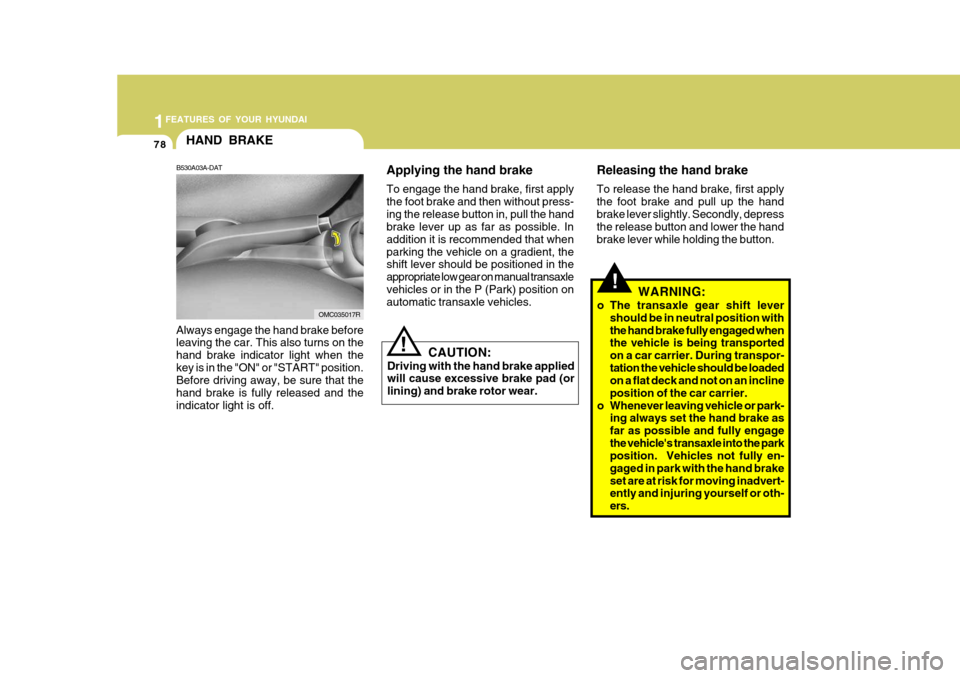
1FEATURES OF YOUR HYUNDAI
78
Applying the hand brake To engage the hand brake, first apply the foot brake and then without press-ing the release button in, pull the hand brake lever up as far as possible. In addition it is recommended that whenparking the vehicle on a gradient, the shift lever should be positioned in the appropriate low gear on manual transaxlevehicles or in the P (Park) position on automatic transaxle vehicles.
!WARNING:
o The transaxle gear shift lever should be in neutral position with the hand brake fully engaged when the vehicle is being transported on a car carrier. During transpor-tation the vehicle should be loaded on a flat deck and not on an incline position of the car carrier.
o Whenever leaving vehicle or park- ing always set the hand brake asfar as possible and fully engagethe vehicle's transaxle into the park position. Vehicles not fully en- gaged in park with the hand brakeset are at risk for moving inadvert- ently and injuring yourself or oth- ers.
CAUTION:
Driving with the hand brake applied will cause excessive brake pad (or lining) and brake rotor wear.
! Releasing the hand brake To release the hand brake, first apply the foot brake and pull up the handbrake lever slightly. Secondly, depress the release button and lower the hand brake lever while holding the button.
HAND BRAKE
Always engage the hand brake before leaving the car. This also turns on the hand brake indicator light when thekey is in the "ON" or "START" position. Before driving away, be sure that the hand brake is fully released and theindicator light is off. B530A03A-DAT
OMC035017R
Page 90 of 232
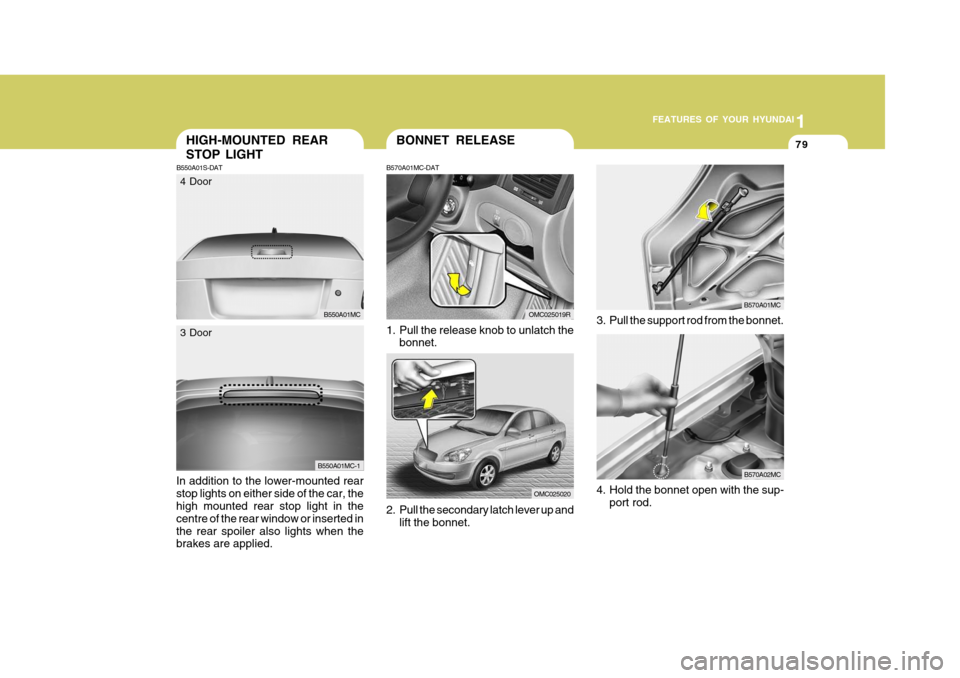
1
FEATURES OF YOUR HYUNDAI
79HIGH-MOUNTED REAR STOP LIGHT
B550A01S-DAT
In addition to the lower-mounted rear stop lights on either side of the car, the high mounted rear stop light in the centre of the rear window or inserted inthe rear spoiler also lights when the brakes are applied.
B550A01MC
4 Door
B550A01MC-1
3 DoorB570A02MC
4. Hold the bonnet open with the sup- port rod.
3. Pull the support rod from the bonnet.
B570A01MC
BONNET RELEASE
B570A01MC-DAT
1. Pull the release knob to unlatch the bonnet.
OMC025019R
OMC025020
2. Pull the secondary latch lever up and lift the bonnet.
Page 128 of 232
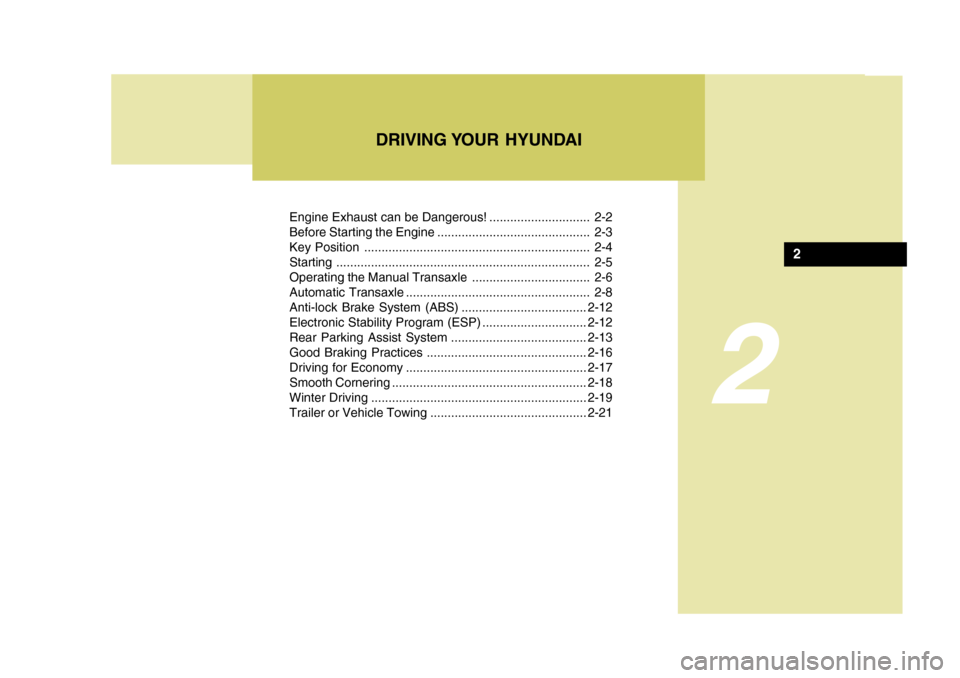
2
Engine Exhaust can be Dangerous! ............................. 2-2
Before Starting the Engine ............................................ 2-3
Key Position ................................................................. 2-4Starting ......................................................................... 2-5
Operating the Manual Transaxle .................................. 2-6
Automatic Transaxle ..................................................... 2-8Anti-lock Brake System (ABS) .................................... 2-12
Electronic Stability Program (ESP) ..............................2-12
Rear Parking Assist System ....................................... 2-13
Good Braking Practices .............................................. 2-16
Driving for Economy .................................................... 2-17
Smooth Cornering ........................................................ 2-18
Winter Driving .............................................................. 2-19
Trailer or Vehicle Towing ............................................. 2-21
DRIVING YOUR HYUNDAI
2
Page 130 of 232

2
DRIVING YOUR HYUNDAI
3
2
DRIVING YOUR HYUNDAI
3TO START THE ENGINEBEFORE STARTING THE EN- GINE
C020A03S-DAT Before you start the engine, you should always:
1. Look around the vehicle to be sure
there are no flat tyres, puddles of oil or water or other indications of pos- sible trouble.
2. After entering the car, check to be
sure the hand brake is engaged.
3. Check that all windows, and lights
are clean.
4. Check that the interior and exterior mirrors are clean and in position.
5. Check your seat, seatback and head- rest to be sure they are in their properpositions.
6. Lock all the doors.
7. Fasten your seat belt and be sure that all other occupants have fas-tened theirs.
8. Turn off all lights and accessories that are not needed.
9. When you turn the ignition switch to "ON", check that all appropriate warn- ing lights are operating and that you have sufficient fuel.
10.Check the operation of warning lights and all bulbs when key is in the "ON"position. C030A01A-AAT COMBINATION IGNITION SWITCH
o If your Hyundai is equipped with a
manual transaxle, place the shift lever in neutral and depress the clutch pedal fully.
o If your Hyundai has an automatic
transaxle, place the shift lever in "P"(park).
o To start the engine, insert the igni- tion key and turn it to the "START"position. Release it as soon as the engine starts. Do not hold the key inthe "START" position for more than 15 seconds.
NOTE:
o For safety, the engine will not start if the clutch pedal is not depressed fully (Manual Transaxle) or the shift lever is not in "P" or "N" Position(Automatic Transaxle).
o The ignition key cannot be turned
from "ACC" position to "LOCK"position unless the shift lever is in the "P" (Park) position or the negative battery terminal is dis-connected from the battery. (For Automatic Transaxle)
!WARNING:
o Always wear appropriate shoes when operating your vehicle. Unsuitable shoes (high heels, skiboots, etc.) may interfere with your ability to use the brake and accel- erator pedal, and the clutch (ifinstalled).
o When you intend to park or stop
the vehicle with the engine on, becareful not to depress the accel- erator pedal for a long period of time. It may overheat the engine orexhaust system and cause fire.
Page 134 of 232

2
DRIVING YOUR HYUNDAI
7
2
DRIVING YOUR HYUNDAI
7
C070D02O-AAT Good Driving Practices
o Never take the car out of gear and coast down a hill. This is extremely hazardous. Always leave the car in gear.
o Don't "ride" the brakes. This can cause them to overheat and mal-function. Instead, when you are driv- ing down a long hill, slow down andshift to a lower gear. When you do this, engine braking will help slow the car.
o Slow down before shifting to a lower gear. This will help avoid over-rev-ving the engine, which can causedamage.
o Slow down when you encounter
cross winds. This gives you muchbetter control of your car.
o Be sure the car is completely stopped
before you attempt to shift into re-verse. The transaxle can be dam- aged if you do not. To shift into reverse, depress the clutch, movethe shift lever to neutral, wait three seconds, then shift to the reverse position.
o Exercise extreme caution when driving on a slippery surface. Beespecially careful when braking,
C070E03A-DAT RECOMMENDED SHIFT POINTS
1-2 2-33-4 4-5
Shift
from-to Recommended
20 km/h 40 km/h 55 km/h 75 km/h
The shift points as shown above are recommended for optimum fuel economy and performance.
C070B01A-DAT Using the Clutch The clutch should be pressed all the way to the floor before shifting, thenreleased slowly. The clutch pedal should fully return to the original posi- tion. Do not rest your foot on the clutchpedal while driving. This can cause unnecessary wear. Do not partially engage the clutch to hold the car on anincline. This causes unnecessary wear. Use the hand brake to hold the car on an incline. Do not operate the clutchpedal rapidly and repeatedly.
Page 135 of 232

2 DRIVING YOUR HYUNDAI
8
!
AUTOMATIC TRANSAXLE
NOTE:Depress the brake pedal and push the button when shifting. Push the button when shift- ing. The selector lever can be shifted freely.
For optimum fuel economy, acceler-ate gradually. The transaxle will auto- matically shift to the second, third andoverdrive gears.
C090A02A-GAT
The highly efficient Hyundai automatic transaxle has four forward speeds and one reverse speed. It has a conven-tional shift pattern as shown in the illustration. CAUTION:
Never shift into "R" or "P" position while the vehicle is moving.
accelerating or shifting gears. On aslippery surface, an abrupt change invehicle speed can cause the drive wheels to lose traction and the ve- hicle to go out of control.
WARNING:
o Avoid high cornering speeds.
o Do not make quick steering wheel movements, such as sharp lanechanges or fast, sharp turns.
o Always wear your seat belts. In a collision crash, an unbeltedperson is significantly more likelyto die than a person wearing a seat belt.
o The risk of rollover is greatly in- creased if you lose control ofyour vehicle at highway speeds.
o Loss of control often occurs if two or more wheels drop off theroadway and the driver oversteers to reenter the roadway.
o In the event your vehicle leaves the roadway, do not steer sharply.Instead, slow down before pullingback into the travel lanes.
o Never exceed posted speed limits.
OMC035014R
!
Page 136 of 232
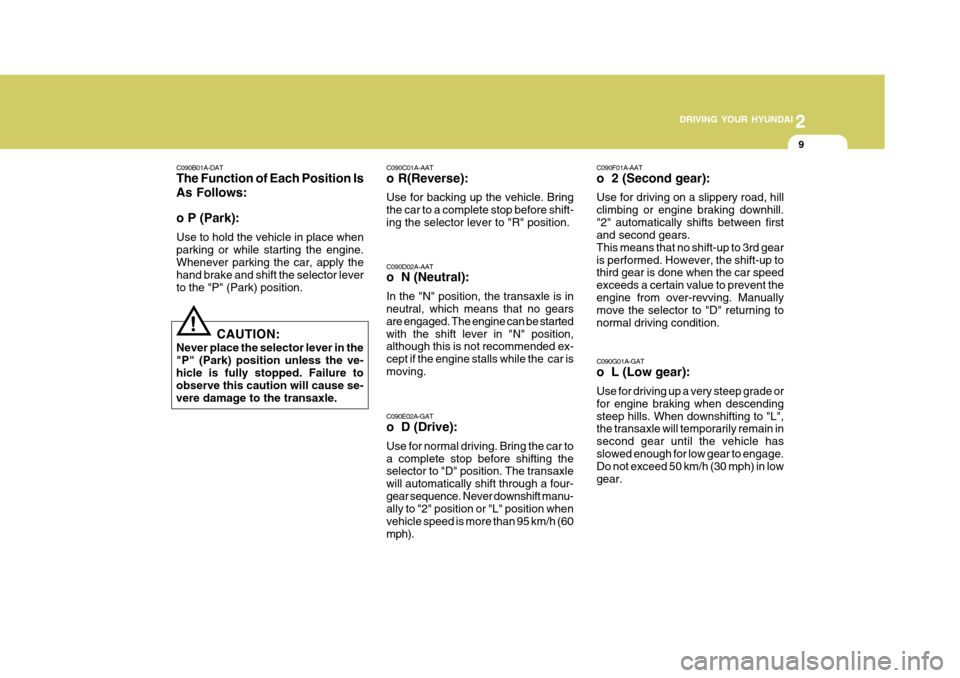
2
DRIVING YOUR HYUNDAI
9
2
DRIVING YOUR HYUNDAI
9
C090B01A-DAT The Function of Each Position Is As Follows: o P (Park): Use to hold the vehicle in place when parking or while starting the engine. Whenever parking the car, apply the hand brake and shift the selector leverto the "P" (Park) position.
! CAUTION:
Never place the selector lever in the "P" (Park) position unless the ve-hicle is fully stopped. Failure to observe this caution will cause se- vere damage to the transaxle. C090C01A-AAT o R(Reverse): Use for backing up the vehicle. Bring the car to a complete stop before shift-ing the selector lever to "R" position. C090D02A-AAT o N (Neutral): In the "N" position, the transaxle is in neutral, which means that no gears are engaged. The engine can be startedwith the shift lever in "N" position, although this is not recommended ex- cept if the engine stalls while the car ismoving.
C090F01A-AAT o 2 (Second gear): Use for driving on a slippery road, hill climbing or engine braking downhill."2" automatically shifts between first and second gears. This means that no shift-up to 3rd gearis performed. However, the shift-up to third gear is done when the car speed exceeds a certain value to prevent the
engine from over-revving. Manually move the selector to "D" returning to normal driving condition.
C090E02A-GAT o D (Drive): Use for normal driving. Bring the car to a complete stop before shifting the selector to "D" position. The transaxle will automatically shift through a four-gear sequence. Never downshift manu- ally to "2" position or "L" position when vehicle speed is more than 95 km/h (60mph). C090G01A-GAT o L (Low gear): Use for driving up a very steep grade or for engine braking when descendingsteep hills. When downshifting to "L", the transaxle will temporarily remain in second gear until the vehicle hasslowed enough for low gear to engage. Do not exceed 50 km/h (30 mph) in low gear.
Page 137 of 232
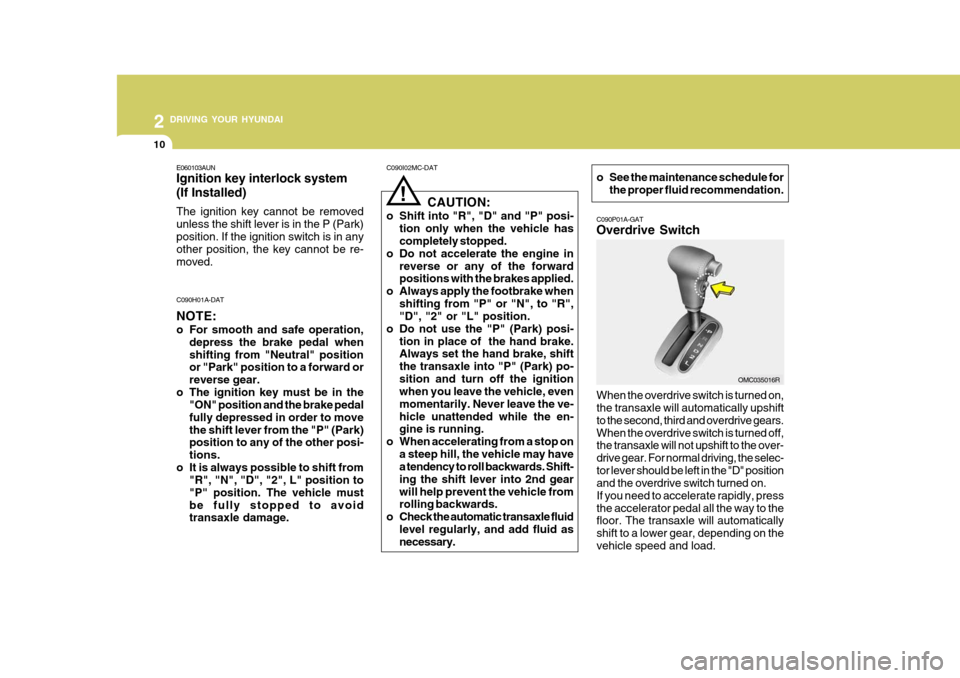
2 DRIVING YOUR HYUNDAI
10
C090P01A-GAT Overdrive Switch
When the overdrive switch is turned on, the transaxle will automatically upshift to the second, third and overdrive gears.When the overdrive switch is turned off,
the transaxle will not upshift to the over- drive gear. For normal driving, the selec-tor lever should be left in the "D" position
and the overdrive switch turned on. If you need to accelerate rapidly, pressthe accelerator pedal all the way to the floor. The transaxle will automatically shift to a lower gear, depending on thevehicle speed and load.
C090I02MC-DAT
!
CAUTION:
o Shift into "R", "D" and "P" posi- tion only when the vehicle has completely stopped.
o Do not accelerate the engine in
reverse or any of the forwardpositions with the brakes applied.
o Always apply the footbrake when shifting from "P" or "N", to "R","D", "2" or "L" position.
o Do not use the "P" (Park) posi- tion in place of the hand brake.Always set the hand brake, shift the transaxle into "P" (Park) po-sition and turn off the ignition when you leave the vehicle, even momentarily. Never leave the ve-hicle unattended while the en- gine is running.
o When accelerating from a stop on a steep hill, the vehicle may havea tendency to roll backwards. Shift- ing the shift lever into 2nd gearwill help prevent the vehicle from rolling backwards.
o Check the automatic transaxle fluid level regularly, and add fluid asnecessary.
C090H01A-DAT NOTE:
o For smooth and safe operation,
depress the brake pedal when shifting from "Neutral" position or "Park" position to a forward or reverse gear.
o The ignition key must be in the "ON" position and the brake pedalfully depressed in order to movethe shift lever from the "P" (Park) position to any of the other posi- tions.
o It is always possible to shift from "R", "N", "D", "2", L" position to"P" position. The vehicle mustbe fully stopped to avoid transaxle damage.
OMC035016R
o See the maintenance schedule for
the proper fluid recommendation.
E060103AUN Ignition key interlock system (If Installed) The ignition key cannot be removed unless the shift lever is in the P (Park)position. If the ignition switch is in any other position, the key cannot be re- moved.